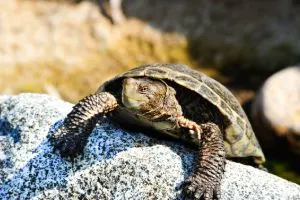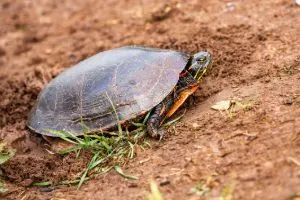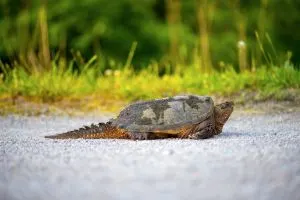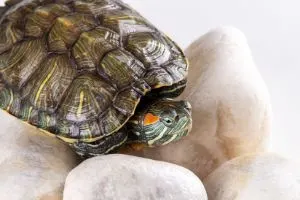There are two native species of turtles in Oregon, but the state is home to six other species as well. With its wide range of climate conditions and over 350 miles of coast, Oregon has the perfect environment for terrestrial, freshwater, and sea turtles.
Despite this, some of these species, such as the western pond turtle, are facing the danger of extinction. Education and raising awareness are the first steps towards saving these testudinal Oregonians from dying out.
So without further ado, let’s delve a little deeper into the following eight turtle species in Oregon.
Turtles in Oregon
1. Western Pond Turtle

- Experience Level: Expert
- Family: Emydidae
- Scientific Name: Actinemys marmorata
- Other Names: Pacific Pond Turtle
- Adult Size: 4-9 inches
- Lifespan: 40-50 years
- Average Price Range: $500
- Where to Buy: TheTurtleSource
The western pond turtle is one of the two turtle species native to Oregon. Despite the fact that it lives along the whole western coast of the United States, it is facing serious challenges in its fight for survival.
In the State of Oregon, the western pond turtle is considered a sensitive/critical species and is illegal to have as a pet.
Despite being called pond turtles, they actually mostly live in rivers and don’t shy away from land, either. In fact, some specimens even spend the winter outside of water.
They are omnivorous and enjoy feeding on insects, crustaceans, algae, grass, and even dead animals.
As far as their character goes, let’s just say that the western pond turtle isn’t exactly the life of the turtle party. They are very shy and skittish. Even turtles that were born and raised in captivity tend to be quite introverted.
2. Western Painted Turtle

- Experience Level: Beginner
- Family: Emydidae
- Scientific Name: Chrysemys picta belli
- Adult Size: 6-10 inches
- Lifespan: 20 years
- Average Price Range: $40-$130
- Recommended Books: Painted Turtles Pet Owners Guide by Ben Team
The western painted turtle is the other Oregon native. Just like its western pond cousin, it is facing extinction and is illegal to own as a pet in this state. If you live in Oregon and would like to have this beautiful specimen as a pet, we have one piece of advice – don’t.
See our exhastive guide on turtle laws to learn more about what you can do.
Ironically, western painted turtles enjoy living in ponds way more than western pond turtles. They can mainly be found in the northern part of Oregon, where they spend their nights at the bottom of lakes, ponds, and marshes and their days basking in the sun.
The western painted turtle can be easily distinguished by the vivid colors of its shell and skin. As they grow, they shed the top layer of their carapace. Once it falls off, the layer usually resembles a burnt leaf.
3. Common Snapping Turtle

- Experience Level: Intermediate
- Family: Chelydridae
- Scientific Name: Chelydra serpentina
- Other Names:
- Adult Size: 8-18 inches
- Lifespan: 30 years
- Average Price Range: $25-$60
- Recommended Books: Snapping Turtle Pet Owner’s Guide by Ben Team
Common snapping turtles are native to eastern states, but they have made their way to Oregon. And if you thought we’re done listing turtles that you cannot own in the state, we’re sorry to say that you are wrong.
It is illegal not only to buy but also to sell, release, own, or import this species. However, this isn’t because the common snapping turtle is endangered – it’s not. It’s because non-native species tend to compete with the native ones and make their survival even more difficult.
Snapping turtles aren’t the friendliest species out there. They’re known to bite when they feel threatened, which is why experts strongly advise against trying to touch or handle them if you spot one in the wild.
4. Red-Eared Slider

- Experience Level: Beginner
- Family: Emydidae
- Scientific Name: Trachemys scripta elegans
- Adult Size: 4-15 inches
- Lifespan: 20 years
- Average Price Range: $15-$70
By now, you’ve probably realized that Oregon isn’t really the best state to own a turtle in. So if you were wondering, no, you cannot legally own a red-eared slider here, mostly for the same reasons why you can’t own a common snapping turtle.
Red-eared sliders might be among the most popular reptilian pets, but they are known to cause trouble in the wild for other species. Due to their invasive nature, they can easily take over nesting sites, basking locations, and food sources from other, less aggressive species.
As the name suggests, this species is easily recognizable (and distinguishable from similar-looking turtles) by two red stripes behind its eyes. Aside from that, they have striped skin and a yellowish-green carapace.
5. Green Sea Turtle

- Experience Level: N/A
- Family: Cheloniidae
- Scientific Name: Chelonia mydas
- Other Names: green turtle
- Adult Size: 31-47 inches
- Lifespan: 80 or more
- Recommended Books: Sea Turtles: A Complete Guide to Their Biology, Behavior, and Conservation by James R. Spotila
The green sea turtle is the first of the four sea turtles that can be found in the coastal areas of Oregon’s waters. It is one of the most popular, most beautiful, and most endangered turtle species in the world.
This is the largest hard-shelled sea turtle species. Unlike most other adult sea turtles, they are mainly herbivores. Their plant-based diet gives their fat a unique shade of green, which is how they got their name. Just in case you were wondering why a brown turtle is called green.
One of the biggest threats that the green sea turtle is facing is commercial harvesting for eggs, food, leather, and even souvenirs. However, they are also often found accidentally entangled in fishing gear.
6. Leatherback Sea Turtle

- Experience Level: N/A
- Family: Dermochelyidae
- Scientific Name: Dermochelys coriacea
- Other Names: lute turtle, leathery turtle
- Adult Size: 55-63 inches
- Lifespan: 45 years
- Recommended Books: The Leatherback Turtle: Biology and Conservation by James R. Spotila and Pilar Santidrián Tomillo
Leatherback sea turtles might be the biggest hard-shelled species, but leatherbacks are the largest species of all turtles in the world. It is believed that the leatherback sea turtle has changed very little, if at all, since the age of dinosaurs.
They prefer tropical and subtropical areas and have the widest distribution among reptiles. They are great swimmers (what a surprise) and are highly migratory – they can swim over 10,000 miles a year to get from foraging to nesting grounds and vice versa.
As the name suggests, the leatherback sea turtle doesn’t have a typical carapace nor scales. It is relatively smooth and leathery in appearance, with parallel ridges running from the front to the back of the shell.
7. Loggerhead Turtle

- Experience Level: N/A
- Family: Cheloniidae
- Scientific Name: Caretta caretta
- Adult Size: 36 inches
- Lifespan: 50 years or more
- Recommended Books: Loggerhead Sea Turtles by Alan B. Bolten and Blair E. Witherington
Loggerheads are easily recognizable by their large heads and strong jaws. These come in quite handy when eating, as they often feed on sea snails, crabs, and other hard-shelled creatures. They will also occasionally munch on some plants and, unfortunately, trash.
Loggerheads are a keystone species. This means that a number of other species depend on them for survival. These include animals that live at the bottom of the sea and feed on their feces, parasites that live on their shells, and predators that feed on their hatchlings.
Despite their importance for the ecosystem, loggerheads are decreasing in numbers and are currently considered a threatened species. Although they are the most common sea turtle species in the U.S., they are threatened by shrimp trawling, oceanfront development, and water pollution, among other issues.
8. Olive Ridley Turtle

- Experience Level: N/A
- Family: Cheloniidae
- Scientific Name: Lepidochelys olivacea
- Other Names: Pacific ridley sea turtle
- Adult Size: 24-28 inches
- Lifespan: 50 years
- Recommended Books: Biology and Conservation of Ridley Sea Turtles by Pamela T. Plotkin
This is one of the smallest sea turtle species and likely one of the most abundant. In the world of turtles, though, that doesn’t mean much, as they are still considered vulnerable, and their population is decreasing.
The olive ridley turtle is generally solitary. However, once a year, they get together for a special occasion – no, not Christmas – the so-called arribada nesting, when large groups of females nest together at the same beach where they hatched.
Sadly, most hatchlings never even make it to the ocean. The seemingly short trip from their nest to the water is riddled with dangerous predators, from crabs to raccoons and birds. On top of that, adult turtles are often killed for their meat.
Conclusion
Although Oregon is home to eight different species of turtles, it might not be the best state for turtle-owners. However, all these rules and regulations have been put in place for one simple reason – to protect these precious creatures from extinction and make their fight for survival at least a little easier.
Be sure to check out our guide for more information on turtle laws in your state and globally.
Of course, much more effort will be necessary to actually reverse the results of centuries of hunting, polluting, and neglect and stop some of the oldest and most unique animals on our planet from dying out.
Other nearby states
